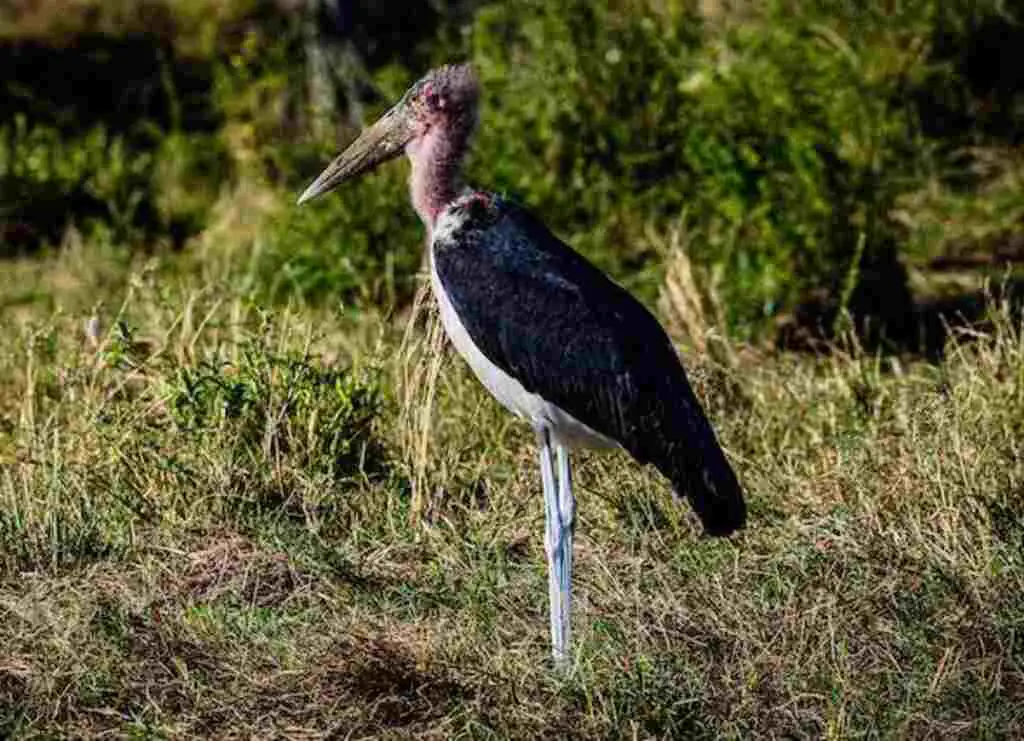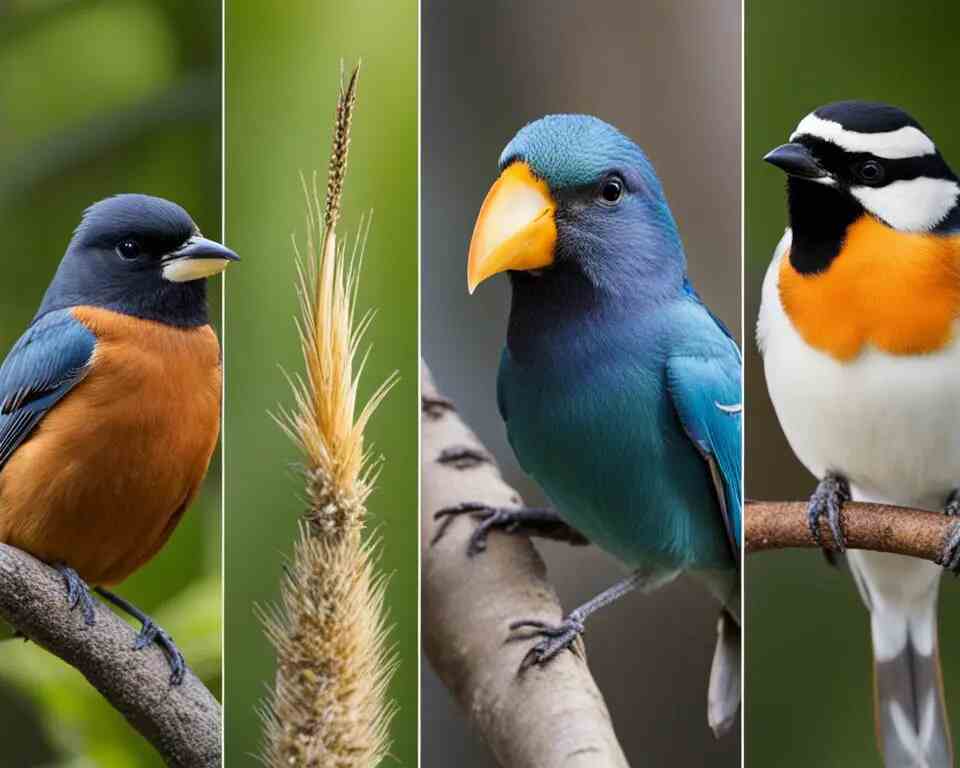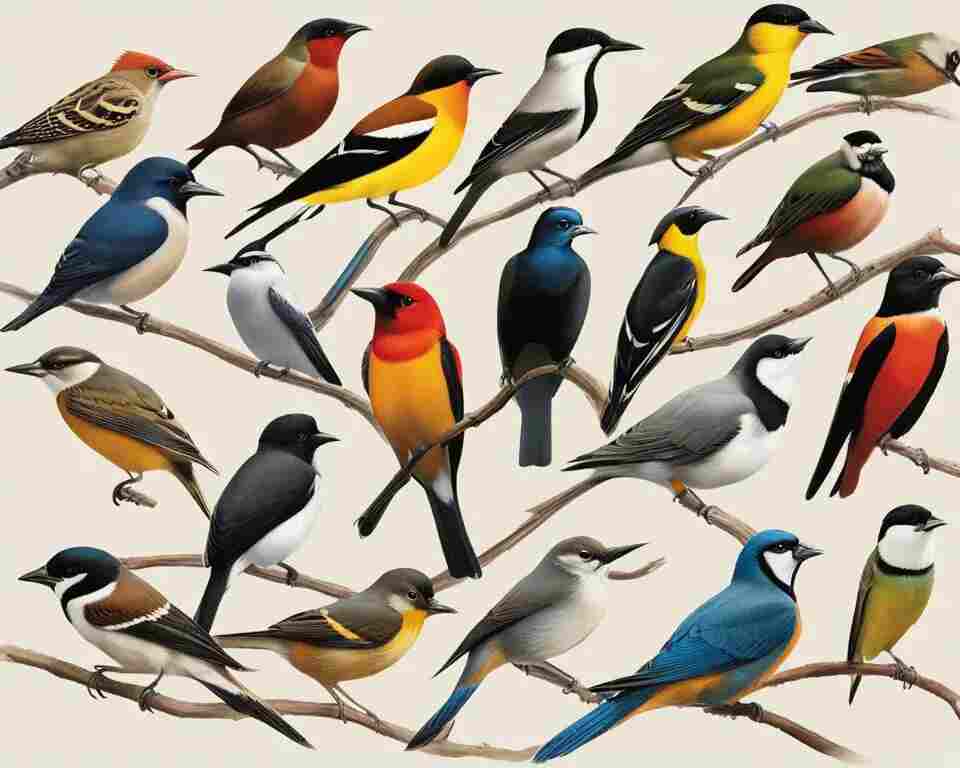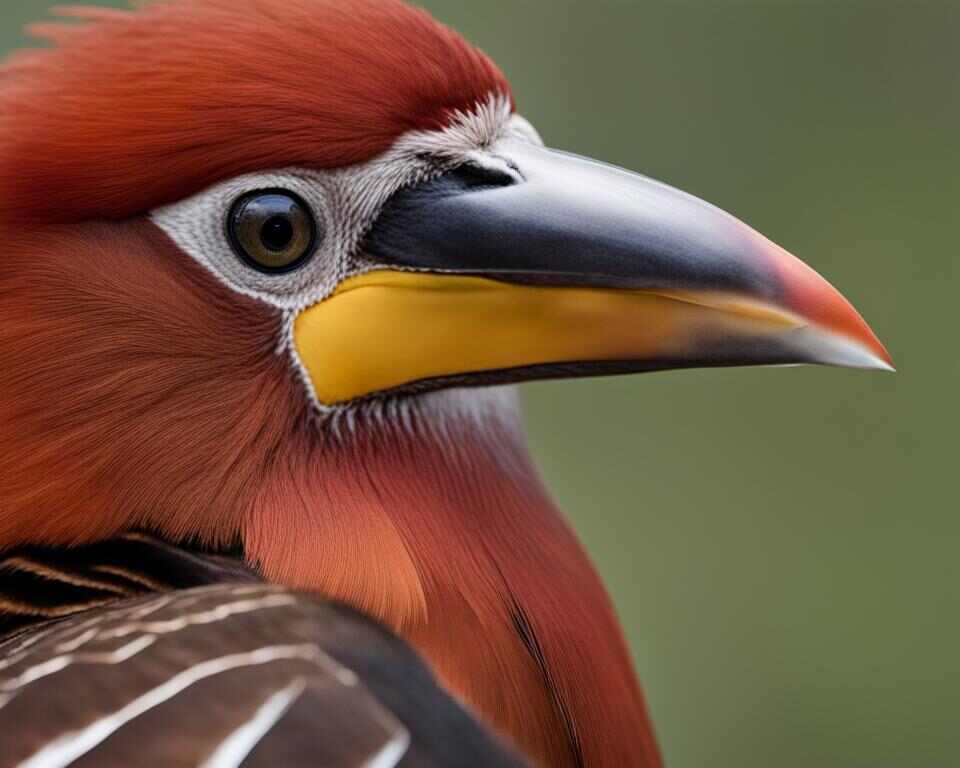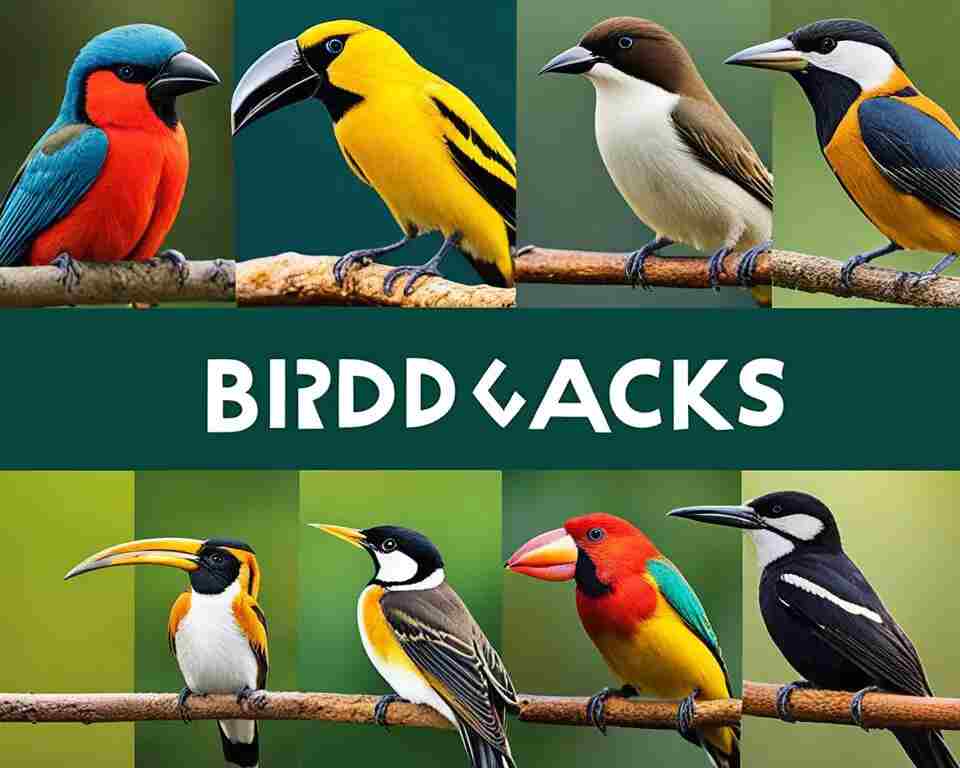Have you ever wondered how birds manage to survive in such different environments? Their beaks are a key part of that survival, and each type is perfectly suited to their needs. From the sharp, curved beak of a hawk to the delicate, probing beak of a hummingbird, birds have evolved a fascinating range of beak shapes for feeding, defense, and even mating. Let’s explore the incredible diversity of bird beaks and how they help our feathered friends thrive in the wild.
Click the Play button below to listen to our podcast:
Table of Contents
- 1 Key Takeaways:
- 2 The Difference Between Beaks and Bills
- 3 Anatomy 101: The Basic Structures of Bird Beaks
- 4 Feeding Functions: How Beak Shape Determines Diet
- 5 Bird Beaks
- 6 Adaptations Beyond Feeding: The Multifunctional Uses of Beaks
- 7 Comparative Analysis: Bird Beaks Across Habitats
- 8 Mimicry and Camouflage: The Role of Beaks in Survival
- 9 Conclusion
- 10 Source Links
- 11 Author
Key Takeaways:
- Bird beaks are highly diverse and have evolved to serve specific functions.
- Bird beaks play a crucial role in feeding, communication, and adaptation.
- Different bird species have beaks that are adapted to their specific habitats and food sources.
- The shape and size of a bird’s beak are closely related to its primary diet.
- Understanding the form and function of bird beaks provides insights into avian ecology and evolutionary history.
The Difference Between Beaks and Bills
When it comes to the terminology of avian mouthparts, the words “beak” and “bill” are often used interchangeably. However, there is a subtle distinction between the two that some ornithologists propose.
According to this view, a beak is typically shorter and designed for poking and stabbing, while a bill is slender and more suited for probing and sweeping. This differentiation suggests that beaks are used for more precise actions, while bills are adapted for tasks requiring finer dexterity.
It is important to note, however, that this distinction between beaks and bills is not universally agreed upon, and both terms are commonly used to refer to the mouthparts of birds. In fact, their usage can vary among different regions and individuals.
Regardless of the terminology used, bird beaks/bills are fascinating structures that exhibit a wide range of shapes and sizes, allowing for diverse functionalities across bird species.
To further explore this intriguing dichotomy, let’s examine the various shapes and forms of bird beaks/bills seen in different species. Through a closer look at these remarkable adaptations, we can gain a deeper understanding of the unique features and capabilities of these avian mouthparts.
| Beak | Bill |
|---|---|
| Poking and stabbing | Probing and sweeping |
| Shorter | Slender |
| More powerful | Finer dexterity |
Anatomy 101: The Basic Structures of Bird Beaks
Bird beaks are fascinating structures that play a vital role in a bird’s survival and adaptation to its environment. Understanding the basic anatomy of bird beaks can provide valuable insights into their functions and capabilities.
Keratin Sheath: The Secret Behind Beak Strength
The strength and durability of bird beaks can be attributed to the keratin sheath that covers the upper and lower jaws. Keratin is a tough protein that also forms hair, nails, claws, and hooves in other animals.
This protective sheath allows birds to withstand the rigors of feeding and provides the necessary strength for various tasks, such as cracking open seeds or capturing prey.
The Role of Nostrils (Nares) and Beak Openings (Gape) in Birds
In addition to the keratin sheath, bird beaks possess other essential features that contribute to their functionality. The nares, or nostrils, located near the base of the beak, serve as the primary openings for respiration.
Birds have a unique ability to breathe while keeping their beaks submerged in water or while holding food in their mouths.
The gape, or the open part of the mouth, in birds serves various purposes and is not solely designed for feeding and capturing prey. While a wide gape can be advantageous for certain bird species in capturing and consuming larger prey, it has other functions as well.
Some birds use their gape as part of their fear and threat displays, combining it with hissing or clapping their beaks to intimidate potential predators. Additionally, during courtship displays, birds may showcase a wide gape to attract mates.
Therefore, the gape is a versatile feature that plays a role in feeding, defense, and reproductive behaviors, depending on the species and their ecological niche.
| Structural Component | Function |
|---|---|
| Keratin Sheath | Provides strength and protection to the beak |
| Nares | Allows for respiration while eating or underwater |
| Gape | Enables wide opening of the mouth for various behaviors |
Feeding Functions: How Beak Shape Determines Diet
The shape of a bird’s beak is closely related to its primary diet and feeding habits. Different beak shapes are adaptations that enable birds to access and consume specific types of food.
For example, birds with long, slender beaks, such as hummingbirds, are adapted for sipping nectar from flowers, while birds with hooked beaks, like raptors, are specialized for tearing flesh.
In this section, we will examine how varying beak shapes determine dietary preferences and explore the fascinating adaptations that allow birds to thrive on a wide range of food sources.
| Beak Shape | Dietary Adaptation |
|---|---|
| Long, thin beak | Adapted for sipping nectar from flowers (e.g., Hummingbirds) |
| Short, stout beak | Adapted for cracking seeds and nuts |
| Straight, pointed beak | Adapted for probing and catching insects |
| Curved, hooked beak | Adapted for tearing flesh and capturing prey |
| Long, thin and curved beak | Adapted for probing in mud and sand for invertebrates (e.g., Curlews) |
| Conical beak | Adapted for general seed or fruit consumption |
| Chisel-like beak | Adapted for chipping and pecking at wood |
| Spoon-shaped beak | Adapted for filter-feeding or scooping up aquatic prey |
| Crossbill beak | Adapted for prying open conifer cones to access seeds |
| Flamingo beak | Adapted for filter-feeding in shallow water habitats |
| Pelican beak | Adapted for scooping up and draining water while hunting |
| Toucan beak | Adapted for reaching and plucking fruits from branches |
| Pouched fish-netting bill | Adapted for catching fish in a pouch-like structure |
| Serrated grazing bill | Adapted for grazing on grasses and vegetation |
| Nectar-sipping bill | Adapted for sipping nectar from flowers (e.g., Other nectar-feeding birds) |
| Nut-cracking bill | Adapted for cracking open nuts and seeds |
| Wading bill | Adapted for probing and sifting through mud for crustaceans |
| Raptor beak | Adapted for stabbing, tearing, and ripping prey |
| Hoopoe beak | Adapted for hunting insects on the ground |
| Woodpecker beak | Adapted for drilling into wood to find insects |
Through the remarkable diversity of beak shapes, birds have evolved to exploit specific food sources in their respective habitats. By examining these adaptations, we gain a deeper understanding of how birds have successfully diversified their diets and adapted to different ecological niches.
Bird Beaks
Bird beaks exhibit a remarkable diversity of shapes and sizes, reflecting the wide range of dietary adaptations seen in avian species. They can be broadly categorized into two types: generalist beaks and specialist beaks.
Generalist Versus Specialist: Dietary Adaptations
Generalist beaks, as the name suggests, are versatile and enable birds to consume a variety of food sources. These beaks are adapted for a general diet consisting of seeds, fruits, nuts, insects, and even small vertebrates. Their shape and size allow for efficient feeding on a wide range of foods, providing these birds with adaptability and flexibility to survive in different environments.
On the other hand, specialist beaks are highly adapted for specific types of prey or food sources. These beaks are finely tuned to meet the unique challenges posed by a particular type of diet. For instance, birds with beaks specialized for cracking seeds have strong, conical beaks that can exert high pressure to break open tough seed shells.
Beaks designed for probing flowers for nectar are long and slender, allowing these birds to reach deep into floral structures to access the sugary reward. Similarly, birds that rely on a diet of fish have sharp, pointed beaks for efficient predation.
This specialization in beak shape is an evolutionary marvel that enables birds to exploit niche food sources and reduce competition within their ecosystems.
It highlights the incredible diversity and adaptability of bird beaks, showcasing nature’s ingenuity in tailoring structures to match specific dietary requirements.
Evolutionary Marvels: Beaks Tailored for Prey
The evolution of beaks tailored for prey has sparked fascination among scientists and bird enthusiasts alike. Birds have evolved an astonishing array of beak shapes and sizes, each suited to capture and consume a particular type of prey.
These adaptations reflect a long history of natural selection and have allowed certain bird species to thrive by exploiting specialized food sources.
For example, the iconic beak of the pelican is perfectly adapted for its unique feeding style. The long, broad beak of the pelican acts as a scoop, enabling it to catch fish by swiftly plunging its beak into the water and scooping up its prey.
Similarly, the amazing beaks of hummingbirds, with their needle-like shape and long, extensible tongues, are ideal for sipping nectar from flowers, providing a valuable pollination service in return.
From the curved beak of the toucan to the sturdy beak of the woodpecker, each specialized adaptation showcases the fascinating diversity of bird beaks and the intricate relationship between form and function in the avian world.
These evolutionary marvels demonstrate nature’s ability to sculpt structures that maximize efficiency and optimize survival in diverse ecological niches.
Adaptations Beyond Feeding: The Multifunctional Uses of Beaks
While feeding is the most well-known function of bird beaks, these structures have several other uses beyond acquiring food. Birds use their beaks for communication, defense, preening, building nests, and even courtship displays. The shape and size of a bird’s beak can influence its ability to perform these various functions.
Comparative Analysis: Bird Beaks Across Habitats
Bird beaks are marvels of adaptation that have evolved to suit various ecological niches and habitats. Across different environments, bird species have developed unique beak adaptations that enable them to find food and thrive in their specific habitats. Let’s explore two fascinating examples of specialized beak adaptations: insectivore beaks and raptorial beaks.
Insectivore Ingenuity: Probing and Grasping Techniques
Insectivores, including birds like woodpeckers and finches, have beaks that are specially adapted for probing and grasping small insects. These beaks are typically long and slender, allowing the birds to reach into crevices or delicate flower structures to extract their prey.
With their intricate beak movements, insectivores can expertly manipulate their beaks to snatch insects on the wing or extract them from hard-to-reach places.
Take the example of the woodpecker’s beak, which is designed to chisel into tree bark and reach insect larvae hidden beneath the surface. The woodpecker’s long and sturdy beak enables it to drill into wood with precision, revealing a banquet of insects.
Similarly, the finch’s thin and pointed beak easily pierces flower petals to access nectar and small insects concealed within.
Raptorial Precision: Beaks Built for Hunting
Raptors, such as eagles and hawks, possess beaks specifically adapted for hunting and capturing prey. These beaks are characterized by their sharp, curved, and powerful structure, which aids in tearing flesh and immobilizing their quarry. Raptors rely on their beaks to efficiently dispatch prey and secure their meals.
For instance, the beak of a bald eagle showcases incredible strength and precision, with its sharp hooked tip ideal for gripping and tearing into fish. The sharpness and curvature of the beak allow the eagle to swiftly snatch fish from the water’s surface, ensuring successful hunts.
Similarly, the hawk’s beak, though smaller, possesses the same raptorial features that enable it to seize and tear smaller prey animals.
| Beak Adaptation | Example Species | Characteristic Features |
|---|---|---|
| Insectivore Beaks | Woodpeckers, Finches | Long and slender beaks for probing and grasping insects, specialized movements for capturing prey in crevices or on the wing |
| Raptorial Beaks | Eagles, Hawks | Sharp, curved beaks for tearing flesh, powerful structure to immobilize prey, ideal for hunting and capturing |
This comparative analysis of bird beaks across habitats highlights the incredible adaptability and diversity within avian species. From the ingenuity of insectivore beaks to the precision of raptorial beaks, each adaptation serves a specific purpose, allowing birds to thrive in their respective ecological niches.
Mimicry and Camouflage: The Role of Beaks in Survival
Beaks play a significant role in the survival of birds through mimicry, camouflage, and deceptive displays. Some bird species use beak coloration as a visual signal during courtship and mating rituals, while others utilize beak shape and coloration to blend in with their surroundings and avoid predation.
In this section, we will explore the fascinating ways in which beaks contribute to the survival strategies of birds and the evolutionary adaptations that enhance their chances of survival.
Deceptive Displays: Beak Coloration and Courtship
In the world of birds, beak coloration plays a crucial role in courtship and mating rituals. Certain species showcase vibrant, attractive beak colors to attract mates and establish their fitness as potential partners.
These colorful beaks serve as visual signals, helping birds communicate their genetic quality and compatibility to potential mates.
From the bright red beak of the Northern Cardinal to the vibrant yellow beak of the American Goldfinch, beak coloration adds charm and allure to the courtship process.
Predator Evasion: Using Beak Shape to Blend In
When it comes to survival, birds employ various strategies to evade predators, and beak shape and coloration play an integral role in this defense. Some bird species have evolved beak shapes that help them blend in with their surroundings, effectively camouflaging themselves from potential predators.
For example, the long, slender beak of the common snipe allows it to probe for food in muddy marshes, while its brownish coloration helps it seamlessly blend with the reeds and vegetation in its habitat. Similarly, the short, sturdy beaks of birds like the African grey hornbill provide them with the ability to hide in tree cavities and crevices.
By utilizing mimicry and camouflage, birds are able to increase their chances of survival in their respective environments. Their beak adaptations not only help them find food but also aid in courtship rituals and protect them from potential threats.
The incredible diversity of beak coloration and shape among bird species showcases the evolution and ingenuity of nature’s design.
Conclusion
In conclusion, bird beaks are incredible structures that have evolved to serve various functions related to feeding, communication, adaptation, and survival. The diverse forms and adaptations of bird beaks allow different species to thrive in their respective habitats and exploit specific food sources.
Understanding the form and function of bird beaks provides valuable insights into avian ecology, behavior, and evolutionary history. By delving into the world of bird beaks, we can appreciate the fascinating adaptations that have shaped avian life and marvel at the ingenuity of nature’s design.
From the versatile beaks of generalist birds to the specialized beaks of specialists, these remarkable structures not only determine a bird’s diet but also play a role in various non-feeding behaviors. Additionally, bird beaks exhibit incredible diversity across different habitats, aiding in insectivore feeding techniques and raptorial hunting skills.
Furthermore, bird beaks contribute to the survival strategies of birds through mimicry, camouflage, and deceptive displays. Whether it is using beak coloration during courtship rituals or blending in with the environment to evade predators, these adaptations highlight the evolutionary marvels that have enhanced bird survival.

